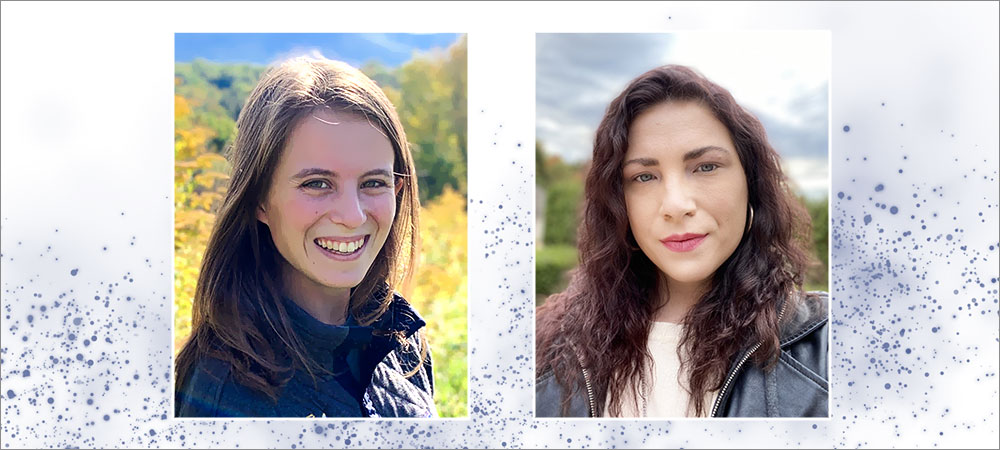Brookhaven Lab Interns Study Airborne COVID-19 Spread
Interns contributed to aerosol modeling research to better understand airborne virus
January 13, 2021

Alison Robey (left) and Cathrine Hamilton (right) collaborated remotely throughout their fall internships.
When Cathrine Hamilton and Alison Robey, fall interns at the U.S. Department of Energy’s Brookhaven National Laboratory, first signed on to collaborate with their mentor Laura Fierce, an associate scientist in the Environmental and Climate Sciences Department, they didn’t imagine they would be contributing to widespread research tackling the COVID-19 pandemic.
Instead of collaborating on climate models, the interns supported the development of simulations in order to study the probability of infection by tiny virus particles traveling in the air.
The research, which is among several COVID-19-focused efforts at Brookhaven Lab, aims to connect the tools of mathematical modeling with aerosol expertise and the expanding body of coronavirus literature. The goal is to provide more accurate insights on the effects of particle size, evolution, and behavior on the chances of infection, which could lead to the design of more effective airborne virus protections.
Hamilton, a Science Undergraduate Laboratory Internships (SULI) participant, and Robey, a Supplemental Undergraduate Research Program (SURP) member, welcomed their unexpected dive into respiratory aerosol modeling, acknowledging the feeling that they’ve contributed to an important and timely mission. Both internship programs are managed by Brookhaven Lab’s Office of Educational Programs (OEP).
“I realized I was really grateful to be able to get up every day and do something that could potentially help anyone and everyone around the world to help combat this virus, to stay safe, to not get sick,” said Hamilton, a chemistry major at Indiana Pennsylvania University. “It’s just been invaluable to do something like that.”
Robey first joined Fierce as a summer intern after graduating from Williams College in May with a Bachelor’s degree in mathematics and environmental studies, and continued with the project this fall.
“This research has provided an amazing opportunity to expand my scientific abilities while collaborating in an area of immediate importance, hopefully developing research that will save lives during the spread of this and future airborne diseases,” Robey said.
Both interns learned to use the programming language Python to code deposition models that simulate how virus particles spread under different conditions, such as when people breathing the same air are wearing masks—or not.
A lack of studies based in the principles of aerosol creation, behavior, and deposition has hindered efforts to best protect the public, and their research will help fill that knowledge gap, Robey said.
“Our rapid progress on this project would not have been possible without Alison and Catherine's help,” Fierce said. “We were all able to collaborate effectively, even without ever meeting in person.”
Hamilton and Robey collaborated with Fierce remotely, meshing their respective science backgrounds in chemistry, math, and physics throughout the fall. In the process, the interns have reviewed and summarized available literature to check their group’s hypotheses against others.
“It’s worked really well to bring together people who think differently and have been trained to think differently,” Hamilton said.
Learning to code is a valuable part of her internship that will help her organize and analyze information in her advanced chemistry labs as she completes her degree, she said.
Beyond refining her technical and research skills this fall, Hamilton said her experience with the Lab has shown her to follow through on her dreams. As someone who worked to earn a GED and a non-traditional undergraduate student juggling kids at home and working while going to school, she hasn't let anything stand in the way of pursuing her goals in science.
She took to heart something that Noel Blackburn, manager of university relations and DOE programs for Brookhaven Lab's OEP, recently told a group of interns. She even wrote it down to remember: “Don’t let your dreams be dreams. Let your interests and passions expedite them so they are actions.”
“I just really want to encourage anyone and everyone who is even thinking about applying for an internship to just go ahead and do it,” Hamilton said. “With the support at Brookhaven Lab and the encouragement here, you can’t ask for better people to be surrounded by.”
Robey, who will move on to the spring SULI program, said she’s gained problem-solving experience in addition to programming skills essential to the mathematical aerosol models. The collaboration with Hamilton and Fierce gave her the opportunity to learn about chemistry and physics quickly, she said.
She said the internship solidified her interest in research, motivating her to apply for ecology Ph.D. programs.
As Robey began her internship, two of her grandparents were fighting COVID-19, putting the potential impact of her experience at the Lab further into perspective.
“They recovered, thankfully, but this has been something that’s been so relevant in my life and everyone’s lives,” she said. “It’s been nice to do something impactful.”
This research is supported by the DOE Office of Science (BER) through the National Virtual Biotechnology Laboratory (NVBL), a consortium of DOE national laboratories focused on the response to COVID-19, with funding provided by the Coronavirus CARES Act. Student participation in this project was supported through SULI, a program funded by the DOE Office of Science, Office of Workforce Development for Teachers and Scientists (WDTS), and SURP, a program run by Brookhaven Lab’s Office of Educational Programs with funding from Brookhaven Science Associates—a partnership between Battelle and The Research Foundation for the State University of New York on behalf of Stony Brook University—which manages Brookhaven Lab.
Brookhaven National Laboratory is supported by the U.S. Department of Energy’s Office of Science. The Office of Science is the single largest supporter of basic research in the physical sciences in the United States and is working to address some of the most pressing challenges of our time. For more information, visit https://energy.gov/science.
Follow @BrookhavenLab on Twitter or find us on Facebook.
2021-17611 | INT/EXT | Newsroom









